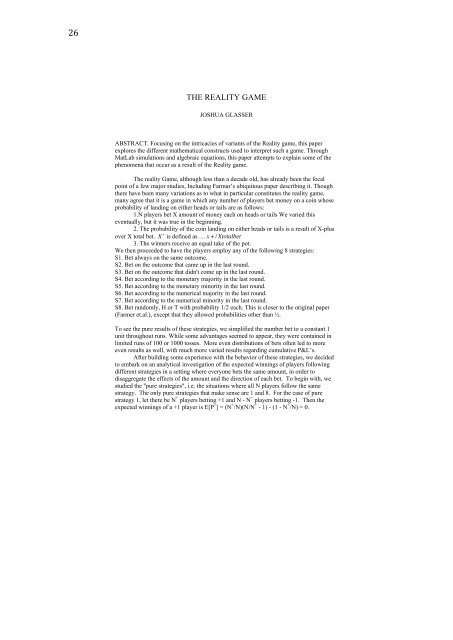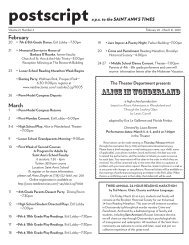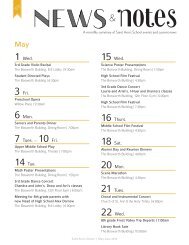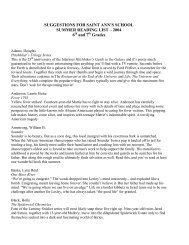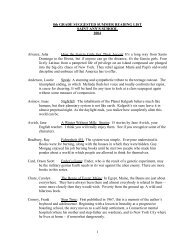Mathematical Journeys - Saint Ann's School
Mathematical Journeys - Saint Ann's School
Mathematical Journeys - Saint Ann's School
You also want an ePaper? Increase the reach of your titles
YUMPU automatically turns print PDFs into web optimized ePapers that Google loves.
26 <br />
THE REALITY GAME<br />
JOSHUA GLASSER<br />
ABSTRACT. Focusing on the intricacies of variants of the Reality game, this paper<br />
explores the different mathematical constructs used to interpret such a game. Through<br />
MatLab simulations and algebraic equations, this paper attempts to explain some of the<br />
phenomena that occur as a result of the Reality game.<br />
The reality Game, although less than a decade old, has already been the focal<br />
point of a few major studies, Including Farmar’s ubiquitous paper describing it. Though<br />
there have been many variations as to what in particular constitutes the reality game,<br />
many agree that it is a game in which any number of players bet money on a coin whose<br />
probability of landing on either heads or tails are as follows:<br />
1.N players bet X amount of money each on heads or tails We varied this<br />
eventually, but it was true in the beginning.<br />
2. The probability of the coin landing on either heads or tails is a result of X-plus<br />
over X total bet. X + is defined as … x + / Xtotalbet<br />
3. The winners receive an equal take of the pot.<br />
We then proceeded to have the players employ any of the following 8 strategies:<br />
S1. Bet always on the same outcome.<br />
!<br />
!<br />
S2. Bet on the outcome that came up in the last round.<br />
S3. Bet on the outcome that didn't come up in the last round.<br />
S4. Bet according to the monetary majority in the last round.<br />
S5. Bet according to the monetary minority in the last round.<br />
S6. Bet according to the numerical majority in the last round.<br />
S7. Bet according to the numerical minority in the last round.<br />
S8. Bet randomly, H or T with probability 1/2 each. This is closer to the original paper<br />
(Farmer et.al.), except that they allowed probabilities other than !.<br />
To see the pure results of these strategies, we simplified the number bet to a constant 1<br />
unit throughout runs. While some advantages seemed to appear, they were contained in<br />
limited runs of 100 or 1000 tosses. More even distributions of bets often led to more<br />
even results as well, with much more varied results regarding cumulative P&L’s.<br />
After building some experience with the behavior of these strategies, we decided<br />
to embark on an analytical investigation of the expected winnings of players following<br />
different strategies in a setting where everyone bets the same amount, in order to<br />
disaggregate the effects of the amount and the direction of each bet. To begin with, we<br />
studied the "pure strategies", i.e. the situations where all N players follow the same<br />
strategy. The only pure strategies that make sense are 1 and 8. For the case of pure<br />
strategy 1, let there be N + players betting +1 and N - N + players betting -1. Then the<br />
expected winnings of a +1 player is E[P + ] = (N + /N)(N/N + - 1) - (1 - N + /N) = 0.<br />
<br />
<br />
<br />
<br />
<br />
<br />
<br />
<br />
<br />
<br />
<br />


